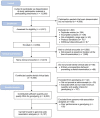Cohort Profile: ZOE 2.0-A Community-Based Genetic Epidemiologic Study of Early Childhood Oral Health
- PMID: 33139633
- PMCID: PMC7663650
- DOI: 10.3390/ijerph17218056
Cohort Profile: ZOE 2.0-A Community-Based Genetic Epidemiologic Study of Early Childhood Oral Health
Abstract
Early childhood caries (ECC) is an aggressive form of dental caries occurring in the first five years of life. Despite its prevalence and consequences, little progress has been made in its prevention and even less is known about individuals' susceptibility or genomic risk factors. The genome-wide association study (GWAS) of ECC ("ZOE 2.0") is a community-based, multi-ethnic, cross-sectional, genetic epidemiologic study seeking to address this knowledge gap. This paper describes the study's design, the cohort's demographic profile, data domains, and key oral health outcomes. Between 2016 and 2019, the study enrolled 8059 3-5-year-old children attending public preschools in North Carolina, United States. Participants resided in 86 of the state's 100 counties and racial/ethnic minorities predominated-for example, 48% (n = 3872) were African American, 22% white, and 20% (n = 1611) were Hispanic/Latino. Seventy-nine percent (n = 6404) of participants underwent clinical dental examinations yielding ECC outcome measures-ECC (defined at the established caries lesion threshold) prevalence was 54% and the mean number of decayed, missing, filled surfaces due to caries was eight. Nearly all (98%) examined children provided sufficient DNA from saliva for genotyping. The cohort's community-based nature and rich data offer excellent opportunities for addressing important clinical, epidemiologic, and biological questions in early childhood.
Keywords: children; community-based studies; early childhood caries; genomics; oral health.
Conflict of interest statement
The authors declare no conflict of interest.
Figures





Similar articles
-
Metabolomics Insights in Early Childhood Caries.J Dent Res. 2021 Jun;100(6):615-622. doi: 10.1177/0022034520982963. Epub 2021 Jan 9. J Dent Res. 2021. PMID: 33423574 Free PMC article.
-
Exploring the genomic basis of early childhood caries: a pilot study.Int J Paediatr Dent. 2018 Mar;28(2):217-225. doi: 10.1111/ipd.12344. Epub 2017 Oct 23. Int J Paediatr Dent. 2018. PMID: 29057527 Free PMC article.
-
Replication of GWAS significant loci in a sub-Saharan African Cohort with early childhood caries: a pilot study.BMC Oral Health. 2021 May 20;21(1):274. doi: 10.1186/s12903-021-01623-y. BMC Oral Health. 2021. PMID: 34016088 Free PMC article.
-
Evaluating the impact of a community developed collaborative project for the prevention of early childhood caries: the Healthy Smile Happy Child project.Rural Remote Health. 2015 Oct-Dec;15(4):3566. Epub 2015 Nov 4. Rural Remote Health. 2015. PMID: 26530126
-
Prevalence and Measurement of Dental Caries in Young Children.Pediatr Dent. 2015 May-Jun;37(3):200-16. Pediatr Dent. 2015. PMID: 26063550 Review.
Cited by
-
A systematic review and meta-analysis on early-childhood-caries global data.BMC Oral Health. 2024 Jul 24;24(1):835. doi: 10.1186/s12903-024-04605-y. BMC Oral Health. 2024. PMID: 39049051 Free PMC article.
-
Selenomonas sputigena acts as a pathobiont mediating spatial structure and biofilm virulence in early childhood caries.Nat Commun. 2023 May 22;14(1):2919. doi: 10.1038/s41467-023-38346-3. Nat Commun. 2023. PMID: 37217495 Free PMC article.
-
Metabolomics Insights in Early Childhood Caries.J Dent Res. 2021 Jun;100(6):615-622. doi: 10.1177/0022034520982963. Epub 2021 Jan 9. J Dent Res. 2021. PMID: 33423574 Free PMC article.
-
BZINB Model-Based Pathway Analysis and Module Identification Facilitates Integration of Microbiome and Metabolome Data.Microorganisms. 2023 Mar 16;11(3):766. doi: 10.3390/microorganisms11030766. Microorganisms. 2023. PMID: 36985339 Free PMC article.
-
An Automated Machine Learning Classifier for Early Childhood Caries.Pediatr Dent. 2021 May 15;43(3):191-197. Pediatr Dent. 2021. PMID: 34172112 Free PMC article.
References
Publication types
MeSH terms
Grants and funding
LinkOut - more resources
Full Text Sources
Medical
Molecular Biology Databases
Miscellaneous

